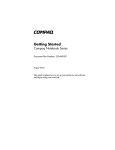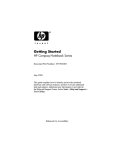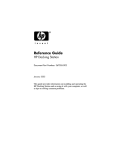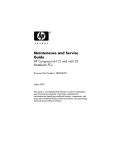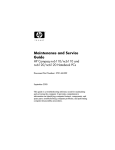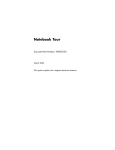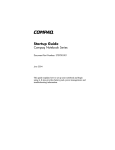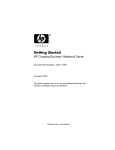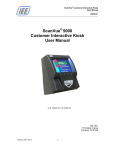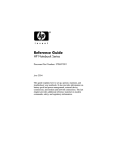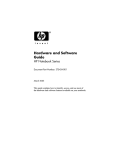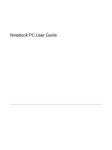Download HP Compaq Notebook Series 393685-002 User's Manual
Transcript
Getting Started HP Compaq Notebook Series Document Part Number: 393685-002 June 2005 This guide explains how to set up your hardware and software, and begin using your notebook in Microsoft® Windows®. © Copyright 2005 Hewlett-Packard Development Company, L.P. Microsoft and Windows are U.S. registered trademarks of Microsoft Corporation. SD Logo is a trademark of its proprietor. Bluetooth is a trademark owned by its proprietor and used by Hewlett-Packard Company under license. The information contained herein is subject to change without notice. The only warranties for HP products and services are set forth in the express warranty statements accompanying such products and services. Nothing herein should be construed as constituting an additional warranty. HP shall not be liable for technical or editorial errors or omissions contained herein. Getting Started HP Compaq Notebook Series Second Edition June 2005 First Edition April 2005 Document Part Number: 393685-002 Contents 1 Hardware Setup Step 1: Identify the Setup Hardware . . . . . . . . . . . . . . . . 1–3 Step 2: Insert the Battery Pack . . . . . . . . . . . . . . . . . . . . . 1–4 Step 3: Connect the Modem. . . . . . . . . . . . . . . . . . . . . . . 1–5 Step 4: Connect the Notebook to External Power . . . . . . 1–8 Step 5: Open the Notebook . . . . . . . . . . . . . . . . . . . . . . . 1–9 Step 6: Turn on the Notebook . . . . . . . . . . . . . . . . . . . . 1–10 2 Software Setup View the Welcome Window . . . . . . . . . . . . . . . . . . . . . . Select Your Regional Preferences . . . . . . . . . . . . . . . . . . Accept the License Agreements. . . . . . . . . . . . . . . . . . . . Name Your Notebook . . . . . . . . . . . . . . . . . . . . . . . . . . . Create User Accounts. . . . . . . . . . . . . . . . . . . . . . . . . . . . Press the Finish Button. . . . . . . . . . . . . . . . . . . . . . . . . . . 2–2 2–5 2–5 2–6 2–7 2–8 3 Next Steps Protect Your Notebook . . . . . . . . . . . . . . . . . . . . . . . . . . Protect the Notebook from Viruses . . . . . . . . . . . . . . Protect Your System Files . . . . . . . . . . . . . . . . . . . . . Protect Your Privacy . . . . . . . . . . . . . . . . . . . . . . . . . Protect the Notebook from Power Surges . . . . . . . . . Use the Notebook Safely . . . . . . . . . . . . . . . . . . . . . . Turn Off the Notebook Properly . . . . . . . . . . . . . . . . Getting Started 3–1 3–2 3–3 3–4 3–5 3–6 3–7 iii Contents Connect to the Internet . . . . . . . . . . . . . . . . . . . . . . . . . . . 3–8 Enable Communication Hardware. . . . . . . . . . . . . . . 3–8 Set Up Internet Service . . . . . . . . . . . . . . . . . . . . . . . 3–9 4 Notebook Features Top Components . . . . . . . . . . . . . . . . . . . . . . . . . . . . . . . 4–2 Lights . . . . . . . . . . . . . . . . . . . . . . . . . . . . . . . . . . . . . 4–2 Pointing Devices . . . . . . . . . . . . . . . . . . . . . . . . . . . . 4–6 Buttons and Switches. . . . . . . . . . . . . . . . . . . . . . . . . 4–8 Keys . . . . . . . . . . . . . . . . . . . . . . . . . . . . . . . . . . . . . 4–12 Front Components . . . . . . . . . . . . . . . . . . . . . . . . . . . . . 4–13 Wireless Antennae (Select Models Only) . . . . . . . . . . . 4–15 Rear Components . . . . . . . . . . . . . . . . . . . . . . . . . . . . . . 4–16 Right-Side Components . . . . . . . . . . . . . . . . . . . . . . . . . 4–18 Left-Side Components . . . . . . . . . . . . . . . . . . . . . . . . . . 4–20 Bottom Components. . . . . . . . . . . . . . . . . . . . . . . . . . . . 4–23 Additional Hardware Components. . . . . . . . . . . . . . . . . 4–26 A System Recovery Safeguarding Your Data. . . . . . . . . . . . . . . . . . . . . . . . . . A–1 Altiris Local Recovery . . . . . . . . . . . . . . . . . . . . . . . . . . . A–2 System Restore Points . . . . . . . . . . . . . . . . . . . . . . . . . . . A–3 Creating a System Restore Point . . . . . . . . . . . . . . . . A–4 Restoring to a Restore Point . . . . . . . . . . . . . . . . . . . A–4 Reinstalling Applications . . . . . . . . . . . . . . . . . . . . . . . . . A–5 Reinstalling Applications from the Hard Drive. . . . . A–6 Reinstalling Applications from Discs . . . . . . . . . . . . A–6 Repairing the Operating System . . . . . . . . . . . . . . . . . . . A–7 Reinstalling the Operating System. . . . . . . . . . . . . . . . . . A–8 Reinstalling Device Drivers and Other Software. . . . . . A–10 Index iv Getting Started 1 Hardware Setup notebook may look slightly different from the illustrations ✎ Your in this chapter. Ä CAUTION: To prevent file corruption and to ensure that the correct drivers are installed: ■ Do not set up the notebook for the first time while the notebook is docked in an optional docking device. ■ During the hardware and software setup procedures: ❏ Do not unplug the notebook from external power. ❏ Do not shut down the notebook or initiate standby or hibernation. ❏ Do connect the modem cable as instructed in the “Step 3: Connect the Modem” section later in this chapter, but do not insert, remove, connect, or disconnect any other device, cable, or cord. Getting Started 1–1 Hardware Setup During hardware setup, you will 1. Identify the hardware you need to set up the notebook. 2. Insert the battery pack into the notebook so that it can begin to charge as soon as the notebook is connected to external power. 3. Connect the modem. 4. Connect the notebook to external power. 5. Open the notebook. 6. Turn on the notebook. After you turn on the notebook, you will be prompted to begin software setup. 1–2 Getting Started Hardware Setup Step 1: Identify the Setup Hardware To set up the notebook for the first time, you need the notebook, the power cord 1, the AC adapter 2, and the battery pack 3. If you would like to use the modem to access the Internet, you will also need the modem cable 4. If you are connecting the modem cable in a country where RJ-11 telephone jacks are not standard, you need the modem adapter 5 to connect the modem cable. (If you purchased the notebook in a country where RJ-11 jacks are not standard, a modem adapter specific to the country in which you purchased the notebook is included with the notebook.) Å WARNING: To reduce potential safety issues, use only the AC adapter or battery pack provided with the computer, a replacement AC adapter or battery pack provided by HP, or a compatible AC adapter or battery pack purchased as an accessory from HP with the computer. Getting Started 1–3 Hardware Setup Step 2: Insert the Battery Pack This notebook supports up to 2 battery packs: ■ One primary lithium-ion battery pack is included with the notebook. ■ The travel battery pack is an optional battery pack that can be attached to the bottom of the notebook. To insert the primary battery pack: 1. Turn the notebook upside down with the rear toward you. 2. Slide the battery pack 1 into the battery bay until it is seated. The battery locking latch 2 automatically locks the battery into place. ) 1–4 Getting Started Hardware Setup Step 3: Connect the Modem To connect the modem so that you can access the Internet: ■ Follow the instructions in this section for connecting the modem to an analog telephone line. – or – ■ Follow the instructions provided by your Internet service provider to connect the notebook to the Internet through a DSL (Digital Subscriber Line) modem, cable modem, or network connection. For more information about these and other Internet connection methods, see the “Connect to the Internet” section in Chapter 3, “Next Steps.” be easier to connect your modem to a telephone line ✎ Itnowmight and set up other Internet connections later, after you have completed software setup. Jacks for analog telephone lines vary by country. Å ■ If you are connecting the modem to a telephone line in a country where RJ-11 (modem) jacks are standard, follow the instructions in the “Connecting the Modem Cable” next in this chapter. ■ If you are connecting the modem to a telephone line in a country where RJ-11 (modem) jacks are not standard, follow the instructions in the “Connecting the Modem with an Adapter” later in this chapter. WARNING: To reduce the risk of electric shock, disconnect the modem from the telephone network before accessing an internal compartment of the notebook. Internal compartments include the memory compartment, the battery bay, and the hard drive bay. Getting Started 1–5 Hardware Setup Connecting the Modem Cable To connect the modem to an analog telephone line that has an RJ-11 (modem) jack: 1. Turn the notebook display-side up on a flat surface near an RJ-11 (modem) jack. 2. If your modem cable contains noise suppression circuitry 1, which prevents interference with TV and radio reception, orient the circuitry end of the cable toward the notebook. 3. Plug the modem cable 2 into the RJ-11 (modem) jack on the notebook. 4. Plug the other end of the modem cable 3 into the telephone jack. wall jacks and modem cables vary in appearance by ✎ Telephone region and country. 1–6 Getting Started Hardware Setup Connecting the Modem with an Adapter To connect the modem to an analog telephone line that does not have an RJ-11 (modem) jack: 1. Turn the notebook display-side up on a flat surface near a telephone jack. 2. If the modem cable contains noise suppression circuitry 1, which prevents interference with TV and radio reception, orient the circuitry end of the cable toward the notebook. 3. Plug the modem cable 2 into the RJ-11 (modem) jack on the notebook. 4. Plug the modem cable 3 into the country-specific modem adapter. 5. Plug the country-specific modem adapter 4 into the telephone jack. wall jacks and modem cables vary in appearance by ✎ Telephone region and country. Getting Started 1–7 Hardware Setup Step 4: Connect the Notebook to External Power To connect the notebook to external AC power: 1. Plug the AC adapter cable 1 into the power connector. (The power connector is on the rear of the notebook.) 2. Plug the power cord 2 into the AC adapter, and then into an AC outlet 3. When the notebook receives AC power, the battery pack begins to charge and the battery light (on the front of the notebook) 4 is turned on. When the battery pack is fully charged, the battery light is turned off. It is recommended that you leave the notebook connected to external power until the battery pack is fully charged and the battery light is turned off. (A partially charged new battery pack can run the notebook after software setup is complete, but battery charge displays will not be accurate until the new battery pack has been fully charged.) cords and AC outlets vary in appearance by region and ✎ Power country. 1–8 Getting Started Hardware Setup Step 5: Open the Notebook To open the notebook: 1. Slide the display release latch 1 to the right to release the display. 2. Raise the display 2. Getting Started 1–9 Hardware Setup Step 6: Turn on the Notebook To turn on the notebook: » Press the power/standby button 1. The power/standby light next to the power/standby button 2 and the power/standby light on the front of the notebook 3 are turned on, and you are prompted to begin software setup. 1–10 Getting Started 2 Software Setup During software setup you can ■ Select regional preferences. ■ Accept license agreements. ■ Name your notebook. ■ Create user accounts. You can change or add any settings you select or skip during the setup process. For instructions, refer to Chapter 2, “Managing Your Software,” in the Help and Support Guide located in the Help and Support Center. To access the Help and Support Center, select Start > Help and Support > User Guides. Software setup begins when you respond to the setup prompt on the notebook screen. Ä CAUTION: If you are prompted to select an operating system language before a window called Welcome to Microsoft Windows is displayed, choose carefully. On some models, the languages that you do not choose are deleted from the system and cannot be restored during software setup. ■ After you respond to the setup prompt, you must complete the entire setup process without interruption. Setup time varies. ■ During software setup, it is normal for some notebook models to pause occasionally for several minutes. These normal pauses are indicated by an hourglass icon. Getting Started 2–1 Software Setup View the Welcome Window The first window in software setup is Welcome to Microsoft Windows. This window welcomes you to your Microsoft® Windows® operating system and introduces you to software setup navigation: ■ To display additional information about the text in any setup window: Select the question mark icon in the lower-right corner of the window or press the f1 key on your keyboard. ■ To continue to the next window: Select the Next button in the lower-right corner of the window. ■ To return to the previous window: Select the Back button in the lower-left corner of the window. (This button is unavailable on the first window, Welcome to Microsoft Windows.) ■ To skip a window without entering a preference: Select the Skip button in the lower-right corner of the window. (This button is unavailable on the first and some succeeding windows.) 2–2 Getting Started Software Setup If your computer model has a TouchPad (select models only), to navigate in a window, slide your finger on the TouchPad 1 in the direction that you want to move the cursor. To select an item, move the cursor over the item, and then press the left TouchPad button 2. Getting Started 2–3 Software Setup If your computer model has a pointing stick (select models only), navigate in a window by pressing the pointing stick 1 in the direction that you want to move the pointer. To select an item, move the pointer over the item, and then press the left pointing stick button 2. 2–4 Getting Started Software Setup Select Your Regional Preferences The next 2 windows prompt you to confirm or select regional preferences. Regional preferences are preset for the country in which you purchased the notebook. ■ Dates and currency window—The Windows operating system will use the region and language preferences you confirm or select in the How should dates and currency appear? window to format dates and currency. Notice that some languages have regional versions. The versions are shown in parentheses after the language name. ■ Time zone window—The Windows operating system will use the time zone you confirm or select in the What time zone are you in? window to set the notebook clock. Notice that you can select a check box to set the notebook clock to adjust to daylight saving time. Accept the License Agreements In the End-User License Agreement window, you must accept both the Microsoft End-User License Agreement and the HP Software Product License Agreement to continue with software setup. ■ To accept both agreements, select Yes, I accept them, and then select Next. ■ To decline both agreements, select No, I don’t accept them, and then select Next. If you decline both agreements, you will not be permitted to use the installed software. On the following screen you will be offered only 2 options: You can choose Back to return to the End-User License Agreement window or choose Shutdown to turn off the notebook. When you start the notebook after selecting Shutdown, the Welcome to Windows window is displayed and you must again begin software setup. Getting Started 2–5 Software Setup Name Your Notebook If you plan to include your notebook on a home network, your notebook must have a unique name. In the What’s your computer’s name? window, you can retain the default name shown in the Computer name text field or choose another name. For example, you might want to base your notebook name on a person’s name, “David,” or a location, “Familyroom.” In order for your notebook name to be displayed on a network, the name ■ Must be no longer than 15 characters. ■ Must include only numerals (0-9), letters (A-Z and a-z), and hyphens. ■ Cannot include spaces. If you like, you can also enter a description of your notebook. The description may contain more characters than the notebook name, as well as spaces and special characters. For example, you could describe your notebook as “David’s game machine.” 2–6 Getting Started Software Setup Create User Accounts In the Who will use this computer? window, you can create a user account for each person who might use the notebook. Windows user accounts enable each notebook user to create a personal Windows notebook environment. A user’s Windows environment might include such customizations as display and security settings, personal files, screen savers, and the appearance of the Windows desktop. When you turn on the notebook in Windows, a prompt to select a Windows user account is displayed. When a Windows user account is selected, Windows opens according to the preferences set by that user. The names you enter in the Who will use this computer? window text fields are displayed on the list of user accounts displayed at Windows startup. Getting Started 2–7 Software Setup Press the Finish Button When the Thank you! window is displayed, read the text, and then select Finish. Your notebook saves your preferences, and then restarts in Windows. Select your Windows user account, and you are ready to begin using your notebook. To protect your notebook and gain Internet access to software updates and online assistance, it is recommended that you begin your notebook use by following the suggestions in the next chapter. Windows instructions in your notebook documentation ✎ All describe Microsoft Windows XP procedures based on the default Windows XP category view. For information about switching between Windows XP classic view and Windows XP category view, select Start > Help and Support > Customizing your computer > Files, folders, and programs > Use Windows classic folders. 2–8 Getting Started 3 Next Steps Protect Your Notebook You can use the information in this section to ■ Protect your notebook from viruses. ■ Protect your system files. ■ Protect your privacy. ■ Protect your notebook from power surges. ■ Use your notebook safely. ■ Turn off your notebook properly. For information about other notebook security features, such as passwords, device disabling, and using an optional security cable lock, refer to the “Security” chapter in the Hardware and Software Guide located in the Help and Support Center. To access the Help and Support Center: » Select Start > Help and Support > User Guides. Getting Started 3–1 Next Steps Protect the Notebook from Viruses When you use the notebook for e-mail, network, or Internet access, you expose the notebook to computer viruses. Computer viruses can damage or disable your operating system, applications, or utilities. Norton AntiVirus software is preinstalled on your notebook to protect against such viruses. Norton Antivirus software can detect and destroy most viruses, and usually repair damage they have caused. To provide protection against newly discovered viruses, Norton Antivirus software must be periodically updated. ■ For information about using and updating your Norton AntiVirus software, and for other information such as troubleshooting: Select Start > All Programs > Norton AntiVirus > Help and Support. ■ For more information about computer viruses: 1. Select Start > Help and Support. 2. Type viruses into the Search box. 3. Press enter. 3–2 Getting Started Next Steps Protect Your System Files System Restore is a Windows operating system feature that enables you to undo harmful changes to your notebook software by restoring your software to an earlier time, called a restore point, when your software was functioning optimally. Restore points are restorable, benchmark “snapshots” of your application, driver, and operating system files. The notebook sets restore points at regular intervals and might set additional restore points whenever you change your personal settings or add software or hardware. Manually setting additional restore points provides additional protection for your system files and settings. It is recommended that you manually set restore points ■ Before you add or extensively modify software or hardware. ■ Periodically, whenever the system is performing optimally. Restoring to any restore point does not affect your data files. For example, restoring your system software to an earlier time will not affect documents or e-mails that you saved after that time. All System Restore procedures are reversible. Setting a Restore Point To set a system restore point manually: 1. Select Start > Help and Support > System Restore. A System Restore window opens. 2. Follow the on-screen directions for setting a restore point. Getting Started 3–3 Next Steps Restoring to a Restore Point To restore the notebook to a previous date and time when it was functioning optimally: 1. Make sure the notebook is connected to reliable external power through the AC adapter. 2. Select Start > Help and Support > System Restore. The System Restore window opens. 3. Follow the on-screen directions for restoring the notebook. Protect Your Privacy When you use the notebook for Internet access, e-mail, or networking, it is possible for unauthorized persons to obtain information about you, your notebook, and your data. Firewall software monitors incoming traffic on your computer by including features such as logging and reporting, automatic alarms, and user interfaces for configuring the firewall. Some firewalls also monitor outgoing traffic. To protect your privacy, it is recommended that you ■ Keep your Windows operating system updated. Many Windows updates contain security enhancements. For information about updating Windows, refer to the Hardware and Software Guide located in the Help and Support Center. To access the Help and Support Center: Select Start > Help and Support > User Guides. ■ Use a firewall such as the Windows operating system firewall that is available on your notebook. To learn more about this firewall: Select Start > Control Panel > Network and Internet Connections > Windows Firewall > General tab. 3–4 Getting Started Next Steps Under some circumstances a firewall can block access to Internet games, interfere with printer or file sharing on a network, or block authorized e-mail attachments. To temporarily solve the problem, disable the firewall, perform the task, and then enable the firewall. To permanently resolve the problem, reconfigure the firewall as follows: ■ If you are using Windows Firewall, select Start > Help and Support to search for instructions on reconfiguring the firewall. ■ If you are using an optional firewall, refer to the firewall documentation or contact the firewall manufacturer. Protect the Notebook from Power Surges To protect the notebook from the power surges that may be caused by irregular electrical service or an electrical storm: ■ Plug the notebook power cord into an optional, high-quality surge protector. Surge protectors are available from most computer or electronics retailers. ■ Provide surge protection on the cable that connects the modem to a telephone line. ■ During an electrical storm, either run the notebook on battery power or shut down the notebook and unplug the power cord. Getting Started 3–5 Next Steps Use the Notebook Safely Å WARNING: To reduce the risk of electric shock or damage to your equipment: ■ Plug the power cord into an AC outlet that is easily accessible at all times. ■ Disconnect power from the notebook by unplugging the power cord from the AC outlet (not by unplugging the power cord from the notebook). ■ If provided with a 3-pin attachment plug on your power cord, plug the cord into a grounded (earthed) 3-pin outlet. Do not disable the power cord grounding pin; for example, by attaching a 2-pin adapter. The grounding pin is an important safety feature. Å WARNING: To reduce the risk of serious injury, read the Safety and Comfort Guide (not available in all languages). It describes proper workstation setup; and proper posture, health, and work habits for notebook users. The Safety and Comfort Guide also provides important electrical and mechanical safety information. This guide is available on the Web at http://www.hp.com/ergo, and in the Help and Support Center. To access the Help and Support Center, select Start > Help and Support > User Guides. Å WARNING: To avoid potential discomfort or burns, do not block the air vents or use the notebook on your lap for extended periods. The notebook is designed to run demanding applications at full power. As a result of increased power consumption, it is normal for the notebook to feel warm or hot when used continuously. The notebook complies with the user-accessible surface temperature limits defined by the International Standard for Safety of Information Technology Equipment (IEC 60950). 3–6 Getting Started Next Steps Å WARNING: To reduce potential safety issues, only the AC adapter or battery pack provided with the computer, a replacement AC adapter or battery pack provided by HP, or a compatible AC adapter or battery pack purchased as an accessory from HP should be used with the computer. For more safety and regulatory information, refer to Regulatory and Safety Notices located in the Help and Support Center. To access the Help and Support Center: » Select Start > Help and Support > User Guides. notebook models may be shipped with a User Guides disc ✎ Some that includes safety and regulatory information. Turn Off the Notebook Properly Whenever possible, turn off the notebook by using the standard Windows shutdown procedure for your operating system: ■ In Windows XP Home: Select Start > Turn Off Computer > Turn Off. ■ In Windows XP Professional: Select Start > Turn Off Computer > Turn Off. (If you connect your notebook to a network domain, the name of the Turn Off Computer button may be replaced by the Shut Down button.) Getting Started 3–7 Next Steps If the notebook does not respond, try the following shutdown procedures: ■ Press ctrl+alt+delete. Then, select Shut Down > Turn Off. ■ If the notebook does not respond to the ctrl+alt+delete procedure, press and hold the power/standby button for at least 5 seconds. Ä You should use the power/standby button to shut down the notebook only when the system does not respond to any of the shutdown procedures listed above. Using the power/standby button to shut down the system can result in file corruption and data loss. Connect to the Internet To connect the notebook to the Internet, you must enable your communication hardware and have an account with an Internet service provider (ISP). All Internet connection software procedures are performed in Windows. Enable Communication Hardware Your modem is enabled when the modem cable is connected to the notebook and to an analog telephone line. ■ If you connected the modem cable during hardware setup, your modem is enabled. Proceed to “Set Up Internet Service” next in this chapter. ■ If you did not connect the modem cable during hardware setup: a. Turn off your notebook. b. Follow the instructions in the “Step 3: Connect the Modem” section of Chapter 1, “Hardware Setup.” c. Start your notebook in Windows. d. Then proceed to “Set Up Internet Service” next in this chapter. 3–8 Getting Started Next Steps For information about setting up a wireless device, visit http://www.hp.com/go/wireless. For more information about modem, wireless, cable, DSL (Digital Subscriber Line) and network connections, select Start > Help and Support. The Help and Support utility provides hardware and software information, instructions, tutorials, and wizards that can help you set up or troubleshoot a variety of connections. Set Up Internet Service You must set up Internet service before you can connect to the Internet. HP has made arrangements with leading ISPs in many locations to help you set up a new Internet account or to configure your notebook to use an existing account. Depending on your location, you might be able to set up Internet service by using an ISP-provided icon on your desktop. In all locations, you can set up Internet service by using the Windows Internet Connection wizard. Using an ISP-Provided Icon If ISP-provided icons are supported in the country in which you purchased your notebook, the icons might be displayed either individually on the Windows desktop or grouped in a desktop folder named Online Services. To set up a new Internet account or configure your notebook to use an existing account, double-click an icon, and then follow the instructions on the screen. Getting Started 3–9 Next Steps Using the Internet Connection Wizard You can use the Windows Internet Connection wizard to connect to the Internet ■ If you already have an account with an ISP. ■ If you have a disc from an ISP. ■ If you do not have an Internet account and would like to select an ISP from the list provided within the wizard. (The list of ISP providers is not available in all regions.) ■ If you have selected an unlisted ISP and the ISP has provided you with such information as a specific IP address, and POP3 and SMTP settings. To access the Internet Connection wizard and instructions for using the wizard: 1. Select Start > Help and Support. 2. In the Search text field, type Make an Internet connection. 3. Then select Search. It is recommended that you select the check box provided within the wizard to enable the Windows Firewall. For more information about firewalls, see the “Protect Your Privacy” section earlier in this chapter. User Guides User guides, reference manuals, and other support information for your computer is available through the Help and Support Center. Select Start > Help and Support > User Guides. 3–10 Getting Started 4 Notebook Features This chapter describes hardware features of the notebook. included with your notebook may vary by ✎ Components geographical region and by model. The illustrations in this chapter identify the standard external features included in most notebook models. Refer to the illustrations that most closely match your notebook model. Getting Started 4–1 Notebook Features Top Components Lights ✎ Refer to the illustration that most closely matches your notebook. Component Description 1 Power/standby light Green: The notebook is on. Blinking green: The notebook is in standby mode. Off: The notebook is off or in hibernation. 2 Wireless lights (2) On: An integrated wireless device, such as a wireless local area network (LAN) device and/or a Bluetooth® device is turned on. (Continued) 4–2 Getting Started Notebook Features Component Description 3 Power/standby light Green: The notebook is on. Blinking green: The notebook is in standby mode. Off: The notebook is off or in hibernation. 4 Battery light Amber: A battery pack is charging. Green: A battery pack is close to full charge capacity. Blinking amber: A battery pack that is the only available power source has reached a low-battery condition. When the battery reaches a critical low-battery condition, the battery light begins blinking more quickly. Off: If the notebook is connected to an external power source, the light is turned off when all batteries in the notebook are fully charged. If the notebook is not connected to an external power source, the light is turned off until the battery reaches a low-battery condition. 5 IDE (Integrated Drive Blinking: The hard drive or optical drive is being accessed. Electronics) drive light 6 Volume mute light On: System sound is turned off. 7 Num lock light On: Num lock is on or the embedded numeric keypad is enabled. 8 Caps lock light On: Caps lock is on. Getting Started 4–3 Notebook Features Component Description 1 Power/standby light Green: The notebook is on. Blinking green: The notebook is in standby mode. Off: The notebook is off or in hibernation. 2 Wireless lights (2) On: An integrated wireless device, such as a wireless LAN device and/or a Bluetooth device is turned on. 3 Power/standby light Green: The notebook is on. Blinking green: The notebook is in standby mode. Off: The notebook is off or in hibernation. (Continued) 4–4 Getting Started Notebook Features Component Description 4 Battery light Amber: A battery pack is charging. Green: A battery pack is close to full charge capacity. Blinking amber: A battery pack that is the only available power source has reached a low-battery condition. When the battery reaches a critical low-battery condition, the battery light begins blinking more quickly. Off: If the notebook is connected to an external power source, the light is turned off when all batteries in the notebook are fully charged. If the notebook is not connected to an external power source, the light is turned off until the battery reaches a low-battery condition. 5 IDE drive light Blinking: The hard drive or optical drive is being accessed. 6 Num lock light On: Num lock is on or the embedded numeric keypad is enabled. 7 Caps lock light On: Caps lock is on. Getting Started 4–5 Notebook Features Pointing Devices TouchPad (Select Models Only) Component Description 1 TouchPad* Moves the pointer and selects or activates items on the screen. Can be set to perform other mouse functions, such as scrolling, selecting, and double-clicking. 2 Left TouchPad button* Functions like the left button on an external mouse. 3 Right TouchPad button* Functions like the right button on an external mouse. 4 TouchPad scroll zone* Scrolls upward or downward. *This table describes default settings. For information about changing the functions of TouchPad features, see the “Setting TouchPad Preferences” in Chapter 3 of the Hardware and Software Guide. 4–6 Getting Started Notebook Features Pointing Stick (Select Models Only) Component Description 1 Pointing stick Moves the pointer and selects or activates items on the screen. 2 Left pointing stick button Functions like the left button on an external mouse. 3 Right pointing stick button Functions like the right button on an external mouse. Getting Started 4–7 Notebook Features Buttons and Switches ✎ Refer to the illustration that most closely matches your notebook. Component 1 Power/standby button* Description When the notebook is: ■ Off, press the button to turn on the notebook. ■ In standby, briefly press the button to to exit standby. ■ In hibernation, briefly press the button to exit hibernation. If the notebook has stopped responding and Microsoft® Windows® shutdown procedures cannot be used, press the power/standby button and hold for at least 5 seconds to turn off the notebook. (Continued) 4–8 Getting Started Notebook Features Component Description 2 Display switch Initiates standby mode if the display is closed while the notebook is turned on. 3 Info Center button Launches Info Center. ✎ 4 Wireless button* For more information about the Info Center, refer to “Using Info Center (Select Models Only)” in the Hardware and Software Guide located in the Help and Support Center. To access the Help and Support Center, select Start > Help and Support > User Guides. Turns the wireless functionality on or off, but does not create a wireless connection. ✎ To establish a wireless connection, a wireless network must already be set up. For more information about establishing a wireless connection from Windows, visit http://www.hp.com/go/wireless. 5 Presentation mode button Turns on Presentation mode. 6 Volume mute button Mutes system sound. 7 Volume down button Decreases system sound. 8 Volume up button Increases system sound. *This table describes default settings. For information about changing the functions of power features, see the “Power Preferences” section in Chapter 2 of the Hardware and Software Guide. For information about changing the functions of wireless features, see Chapter 6 of the Hardware and Software Guide. Getting Started 4–9 Notebook Features Component 1 Power/standby button* Description When the notebook is: ■ Off, press the button to turn on the notebook. ■ In standby, briefly press the button to to exit standby. ■ In hibernation, briefly press the button to exit hibernation. If the notebook has stopped responding and Microsoft Windows shutdown procedures cannot be used, press the power/standby button and hold for 5 seconds to turn off the notebook. 2 Display switch Puts the notebook in standby if the display is closed while the notebook is turned on. (Continued) 4–10 Getting Started Notebook Features Component Description 3 Wireless button* Turns the wireless functionality on or off, but does not create a wireless connection. ✎ To establish a wireless connection, a wireless network must already be set up. For more information about establishing a wireless connection from Windows, visit http://www.hp.com/go/wireless. *This table describes default settings. For information about changing the functions of power features, see the “Power Preferences” section in Chapter 2 of the Hardware and Software Guide. For information about changing the functions of wireless features, see Chapter 6 of the Hardware and Software Guide. Getting Started 4–11 Notebook Features Keys notebook may look slightly different from the illustration in ✎ Your this section. Component Description 1 Function keys Execute frequently used system functions when pressed in combination with the fn key. 2 fn key Executes frequently used system functions when pressed in combination with a function key or the esc key. 3 Windows logo key Displays the Microsoft Windows Start menu. 4 Windows applications key Displays a shortcut menu for items beneath the pointer. 5 Keypad keys Can be used like the keys on an external numeric keypad. 4–12 Getting Started Notebook Features Front Components ✎ Refer to the illustration that most closely matches your notebook. Component Description 1 Infrared port Provides wireless communication between the notebook and an optional IrDA-compliant device. 2 Speakers (2) Produce system sound. 3 Digital Media Slot Supports 6 optional digital memory card formats: SD (Secure Digital) Memory Card, MultiMediaCard, Memory Stick, Memory Stick Pro, Smart Media, and xD-Picture Card. (select models only) Ä This notebook does not support adapters in the 6-in-1 Digital Media Slot. Inserting any kind of adapter into your Digital Media Slot can damage the media card. 4 6-in-1 Digital Media Slot light On: Slot is accessing a digital (select models only) 5 Display release latch Getting Started memory card. Opens the notebook. 4–13 Notebook Features Component Description 1 Speaker Produce system sound. 2 Display release latch Opens the notebook. 4–14 Getting Started Notebook Features Wireless Antennae (Select Models Only) Å WARNING: Exposure to Radio Frequency Radiation. The radiated output power of this device is below the FCC radio frequency exposure limits. Nevertheless, the device should be used in such a manner that the potential for human contact during normal operation is minimized. To avoid the possibility of exceeding the FCC radio frequency exposure limits, human proximity to the antennae should not be less than 20 cm (8 inches) during normal operation, including when the notebook display is closed. On select notebook models, there are 2 wireless antennae that send and receive wireless device signals. They are not visible from the outside of the notebook. notebook may look slightly different from the illustration in ✎ Your this section. Getting Started 4–15 Notebook Features Rear Components ✎ Refer to the illustration that most closely matches your notebook. Component Description 1 Security cable slot Attaches an optional security cable to the notebook. Ä Security solutions are designed to act as deterrents. These deterrents may not prevent a product from being mishandled or stolen. 2 Power connector Connects an AC adapter, or an optional power adapter. 3 Parallel port Connects an optional printer. 4 S-Video-out jack Connects an optional S-Video device such as a television, VCR, camcorder, overhead projector, or video capture card. 4–16 Getting Started Notebook Features Component Description 1 Security cable slot Attaches an optional security cable to the notebook. Ä 2 Power connector Getting Started Security solutions are designed to act as deterrents. These deterrents may not prevent a product from being mishandled or stolen. Connects an AC adapter, or an optional power adapter. 4–17 Notebook Features Right-Side Components ✎ Refer to the illustration that most closely matches your notebook. Component Description 1 Audio-out (headphone) jack Produces system sound when connected to optional powered stereo speakers, headphones, headset, or television audio. 2 Audio-in (microphone) jack Connects an optional stereo or monaural microphone. 3 USB ports (2) Connect USB 1.1- and 2.0-compliant devices to the notebook using a standard USB cable, or connect an optional External MultiBay II to the notebook. The MultiBay II must also be connected to an external power source. 4 Optical drive Reads an optical disc. (select models only) 5 Optical drive button Releases the media tray. (select models only) 6 Serial port 4–18 Connect an optional serial device. Getting Started Notebook Features Component Description 1 Audio-out (headphone) jack Produces system sound when connected to optional powered stereo speakers, headphones, headset, or television audio. 2 Audio-in (microphone) jack Connects an optional stereo or monaural microphone. 3 Optical drive Reads an optical disc. (select models only) 4 Optical drive button Releases the media tray. (select models only) Getting Started 4–19 Notebook Features Left-Side Components ✎ Refer to the illustration that most closely matches your notebook. Component Description 1 USB ports (2) Connect USB 1.1- and 2.0-compliant devices to the notebook using a standard USB cable, or connect an optional External MultiBay II to the notebook. The MultiBay II must be connected to an external power source. 2 External monitor port Connects an external monitor. 3 RJ-11 (modem) jack Connects a modem cable. 4 RJ-45 (network) jack Connects a network cable. (Continued) 4–20 Getting Started Notebook Features Component Description 5 1394 port Connects an optional IEEE 1394 device, such as a camcorder. 6 PC Card slots (2) Support optional Type I, Type II, or Type III 32-bit (CardBus) or 16-bit PC Cards. Some models may be shipped with a smart card reader in the bottom card slot. 7 PC Card slot eject buttons (2) Eject PC Cards from the PC Card slots. Getting Started 4–21 Notebook Features Component Description 1 USB ports (2) Connect USB 1.1- and 2.0-compliant devices to the notebook using a standard USB cable, or connect an optional External MultiBay II to the notebook. The MultiBay II must be connected to an external power source. 2 External monitor port Connects an external monitor. 3 RJ-11 (modem) jack Connects a modem cable. 4 RJ-45 (network) jack Connects a network cable. 5 1394 port Connects an optional IEEE 1394 device, such as a camcorder. 6 PC Card slot (1) Supports an optional Type I, Type II, or Type III 32-bit (CardBus) or 16-bit PC Card. 7 PC Card slot eject button (1) Ejects a PC Card from the PC Card slot. 4–22 Getting Started Notebook Features Bottom Components ✎ Refer to the illustration that most closely matches your notebook. Component Description 1 Primary battery bay Holds the primary battery pack. 2 Primary battery release Release the primary battery pack from the battery bay. latches (2) 3 Travel battery connector Connects an optional travel battery. 4 Expansion memory module Contains the expansion memory module slot. compartment (Continued) Getting Started 4–23 Notebook Features Component Description 5 Hard drive bay Holds the hard drive. 6 Vents (4) Enable airflow to cool internal components. Ä 7 Docking connector 4–24 To prevent overheating, do not obstruct vents. Use the notebook only on a hard, flat surface. Do not allow another hard surface, such as a printer, or a soft surface, such as pillows, thick rugs, or clothing, to block the airflow. Connects the notebook to an optional docking device. Getting Started Notebook Features Component Description 1 Primary battery bay Holds the primary battery pack. 2 Primary battery release Release the primary battery pack from the battery bay. latches (2) 3 Travel battery connector Connects an optional travel battery. 4 Expansion memory module Contains the expansion memory module slot. compartment 5 Hard drive bay Holds the hard drive. 6 Vents (4) Enable airflow to cool internal components. Ä Getting Started To prevent overheating, do not obstruct vents. Use the notebook only on a hard, flat surface. Do not allow another hard surface, such as a printer, or a soft surface, such as pillows, thick rugs, or clothing, to block the airflow. 4–25 Notebook Features Additional Hardware Components Component Description 1 Power cord* Connects an AC adapter to an AC electrical outlet. 2 AC adapter Converts AC power to DC power. 3 Primary battery pack Powers the notebook when the notebook is not connected to external power. 4 Modem cable* Connects an internal modem to an RJ-11 telephone jack or to a country-specific modem adapter. (select models only) *Modem cables and power cords vary in appearance by region and country. Battery packs vary by model. 4–26 Getting Started A System Recovery The notebook system recovery process provides several ways to recover optimal system functionality. For best results, attempt to recover optimal notebook functionality by using the following procedures in the order described here. Safeguarding Your Data Software or devices added to the notebook can cause your system to become unstable. To safeguard your documents, store personal files in the My Documents folder and periodically create a backup copy of the My Documents folder. Getting Started A–1 System Recovery Altiris Local Recovery Altiris Local Recovery is a preloaded application that protects the files on your notebook by storing copies of files, called snapshots. If files on your notebook are accidentally deleted or corrupted, you can easily restore the files yourself. You can also restore your complete file system to a previous state. Altiris Local Recovery provides protection of files by backing up files to a hidden Altiris recovery partition. When you install the software, the Recovery Agent Partition Wizard guides you through the process of creating the recovery partition. After the partition is created, the notebook restarts and creates the first snapshot. After the snapshot is created, the notebook restarts, making the snapshot available for recovery through Windows. By default, Local Recovery automatically takes snapshots of your files on a regular basis. You can change the snapshot schedule. For more information, refer to the Altiris Local Recovery Help. To access your snapshots in the Altiris Recovery Agent folder: 1. Right-click the Altiris Recovery Agent icon on your desktop. 2. Click Open. To restore one of the listed snapshots: » Drag the snapshot file to the appropriate location on your hard drive. For more information on configuring and using Altiris Local Recovery, visit the HP Web site at http://www.hp.com/go/easydeploy, or open the software and click Help on the menu bar. A–2 Getting Started System Recovery System Restore Points System Restore is an operating system feature that allows you to reverse undesirable changes to your notebook by restoring the notebook to an earlier state, called a restore point. A restore point is a “snapshot” of your software, drivers, and operating system files at a particular time. The notebook automatically creates restore points at regular intervals and may create additional restore points when you change your personal settings or add software or hardware. You can manually create additional restore points to provide increased protection for your system files and settings. It is recommended that you manually create restore points ■ Before you add or extensively modify software or hardware. ■ Periodically, whenever the system is performing optimally. Restoring to any restore point does not affect your data files. For example, restoring your system software to an earlier state will not affect documents or e-mails that you saved after that time. you do not like the results of your restoration, you can ✎ Ifreverse the restoration. Getting Started A–3 System Recovery Creating a System Restore Point To create a system restore point: 1. Select Start > Help and Support. 2. Click System Restore. The System Restore window opens. 3. Click Create a restore point, and then click Next. 4. Follow the on-screen instructions. Restoring to a Restore Point To restore the notebook to a previous date and time when it was functioning optimally: 1. Select Start > Help and Support. 2. Click System Restore. The System Restore window opens. 3. Click Restore my computer to an earlier time, and then click Next. 4. Follow the on-screen instructions. A–4 Getting Started System Recovery Reinstalling Applications Applications preinstalled or preloaded on your notebook can be reinstalled by using the Recovery disc or a third-party software disc. cases, the applications preloaded on your notebook, ✎ Insuchmostas those available in the Software Setup utility, can be reinstalled from your hard drive. To access the Software Setup utility, select Start > All Programs > Software Setup. The application reinstallation process replaces corrupted system files within the application and reinstalls deleted system files within the application. ■ In most cases: If the application you are reinstalling is still installed on your notebook, the reinstallation process does not affect your settings within the application. ■ In all cases: If an application has been deleted from your notebook, the reinstallation process reinstalls the application or utility to the factory image but cannot restore your personal settings. Getting Started A–5 System Recovery Reinstalling Applications from the Hard Drive To reinstall a preloaded application or utility from your hard drive: 1. Select Start > All Programs > Software Setup, and then follow the instructions on the screen. 2. When you are prompted to select the software you want to reinstall, select or clear the appropriate check boxes. Reinstalling Applications from Discs To reinstall applications from discs: 1. Insert the disc into the optical drive. ❏ If autorun is enabled, an installation wizard opens. ❏ If autorun is disabled, select Start > Run. Enter x:\setup.exe where x is your optical drive designation and then select OK. 2. When the installation wizard opens, follow the installation instructions on the screen. 3. Restart the notebook if prompted. A–6 Getting Started System Recovery Repairing the Operating System To attempt an operating system repair without deleting your personal data, use the Operating System disc that was shipped with the notebook: notebook does not have an optical drive, you may need ✎ Ifto your connect to an optional external MultiBay. 1. Connect the notebook to external power through the AC adapter and turn on the notebook. 2. Immediately insert the Operating System disc into the notebook. 3. Press and hold the power/standby button for at least 5 seconds to turn off the computer. 4. Press the power/standby button again to turn on the notebook. 5. When prompted, press any key to start from the disc. After a few minutes, you may need to select your language, and then the Setup Wizard opens. On the “Welcome to Setup” page, do not press R (step 8 in ✎ this procedure) until you have completed steps 6 and 7. 6. Press enter to continue. A licensing agreement page is displayed. 7. Press f8 to accept the agreement and continue. The “Setup” page is displayed. 8. Press R to repair the selected Windows installation. The repair process begins. This process takes 1 to 2 hours to complete. The notebook restarts in Windows after the process is complete. Getting Started A–7 System Recovery Reinstalling the Operating System Ä CAUTION: To protect your personal data and the software installed on the notebook, back up your data before reinstalling the operating system. See the Windows online Help utility to learn more about backing up your files. Select Start > Help and Support. Then type “backup” in the Search box. the reinstallation, you may be prompted for your ✎ During Product Key. Your Product Key is provided on the Microsoft Certificate of Authenticity label on the bottom of the notebook. If other recovery efforts do not successfully repair the operating system, you can reinstall it. To reinstall the operating system: notebook does not have an optical drive, you may need ✎ Ifto your connect to an optional external MultiBay. 1. Connect the notebook to external power through the AC adapter and turn on the notebook. 2. Immediately insert the Operating System disc into the notebook. 3. Press and hold the power/standby button for at least 5 seconds to turn off the notebook. 4. Press the power/standby button again to turn on the notebook. 5. When prompted, press any key to start from the disc. After a few minutes, you may need to select your language, and then the Setup Wizard opens. 6. Press enter to continue. A licensing agreement page is displayed. 7. Press f8 to accept the agreement and continue. The “Setup” page is displayed. A–8 Getting Started System Recovery 8. Press esc to continue installing a new copy of the operating system instead of repairing it. 9. Press enter to set up the operating system. 10. Press C to continue setup using this partition. 11. Select Format the partition using the NTFS file system (Quick), and then press enter. Ä Formatting this drive deletes all current files. 12. Press F to format the drive. The reinstallation process begins. This process takes 1 to 2 hours to complete. The notebook restarts in Windows when the process is complete. Getting Started A–9 System Recovery Reinstalling Device Drivers and Other Software After the operating system installation process is complete, you must reinstall drivers. To reinstall drivers, use the Recovery disc included with the notebook: 1. While running Windows, insert the Recovery disc into the optical drive. 2. If the disc does not start immediately: a. Select Start > Run. b. Then type D:\SWSETUP\APPINSTL\SETUP.EXE where D indicates the optical drive. 3. Follow the on-screen instructions for installing the drivers. After the drivers are reinstalled, you must reinstall any software you added to the notebook. Follow the installation instructions provided with the software. A–10 Getting Started Index 1394 port 4–21, 4–22 6-in-1 Digital Media Slot 4–13 6-in-1 Digital Media Slot light 4–13 A AC adapter connecting 1–8 identifying 4–26 Altiris Local Recovery A–2 antennae 4–15 antivirus software 3–2 applications key, Windows 4–12 applications, reinstalling or repairing A–5 audio-in (microphone) jack 4–18, 4–19 audio-out (headphone) jack 4–18, 4–19 B battery bay 4–23, 4–25 battery light displaying charge status 1–8 identifying 4–3, 4–5 Getting Started battery pack charging 1–8 identifying 4–26 inserting 1–4 battery pack release latch 4–23, 4–25 bays battery 4–23, 4–25 hard drive 4–24, 4–25 Bluetooth device, wireless light 4–2, 4–4 buttons Info Center 4–9 mute 4–9 optical drive 4–18, 4–19 PC Card Slot eject 4–21, 4–22 power/standby 4–8, 4–10 Presentation mode 4–9 TouchPad 2–3, 2–4, 4–6 volume 4–9 wireless 4–9, 4–11 Index–1 Index Index–2 C D cables modem 1–5, 3–5, 4–22, 4–26 network 4–22 USB 4–18, 4–20, 4–22 caps lock light 4–3, 4–5 category view, Windows 2–8 CDs, ISP 3–10 classic view, Windows 2–8 clock, setting notebook 2–5 compartments, memory 4–23, 4–25 components bottom 4–23 front 4–13 left-side 4–20 rear 4–16 right-side 4–18 top 4–2 connectors docking 4–24 power 4–16, 4–17 travel battery 4–23, 4–25 cord, power connecting 1–8 identifying 4–26 surge protection 3–5 country-specific modem adapter connecting 1–7 identifying 1–3 currency settings, software setup 2–5 date settings, software setup 2–5 daylight saving time setting, software setup 2–5 display release latch 4–13, 4–14 display switch, identifying 4–9, 4–10 docking connector 4–24 drives hard 4–24, 4–25 optical 4–18, 4–19 DSL connections 1–5, 3–9 E eject buttons optical drive 4–18, 4–19 PC Card Slot 4–21, 4–22 electrical storm, safety issues 3–5 exhaust vents 4–24, 4–25 F firewalls 3–4 fn key 4–12 function keys 4–12 H hard drive bay, indentifying 4–24, 4–25 headphone (audio-out) jack 4–18, 4–19 HP Software Product License Agreement 2–5 Getting Started Index I L IDE drive light 4–3, 4–5 IEC 60950 compliance 3–6 IEEE 1394 port 4–21, 4–22 Info Center button 4–9 infrared port 4–13 Internet connection enabling hardware 1–5, 3–8 setting up Internet service 3–9 Internet Connection wizard 3–10 ISP service, setting up 3–9 language settings, software setup 2–1, 2–5 latch battery pack release 4–23, 4–25 display release 4–13, 4–14 lights 6-in-1 Digital Media Slot 4–13 battery 1–8, 4–3, 4–5 caps lock 4–3, 4–5 IDE drive 4–3, 4–5 mute 4–3 num lock 4–3, 4–5 power/standby 1–10, 4–3, 4–4 power/standby button 1–10 wireless 4–2, 4–4 lock, security cable 4–16, 4–17 J jacks audio-in (microphone) 4–18, 4–19 audio-out (headphone) 4–18, 4–19 RJ-11 (modem) 1–5, 4–20, 4–22, 4–26 RJ-45 (network) 4–22 K keypad keys 4–12 keys fn 4–12 function 4–12 keypad 4–12 Windows applications 4–12 Windows logo 4–12 Getting Started M memory module compartment 4–23, 4–25 Memory Stick 4–13 Memory Stick Pro 4–13 microphone (audio-in) jack 4–18, 4–19 Microsoft End-User License Agreement 2–5 modem connecting 1–5, 3–8 country-specific adapter 1–3, 1–7 Index–3 Index setting up Internet service 3–8 surge protection 3–5 virus protection 3–2 modem (RJ-11) jack 1–5 modem cable, connecting 1–5, 3–8 monitor port 4–20, 4–22 MultiMediaCard 4–13 mute button 4–9 mute light 4–3 N navigation, software setup 2–2 network cable 4–22 network connections 3–9 networks (RJ-45) jack 4–22 noise suppression circuitry, modem cable 1–6 Norton AntiVirus 3–2 notebook description and name settings, software setup 2–6 notebook features 4–1 num lock light 4–3, 4–5 O Online Services folder 3–9 opening the notebook 1–9 operating system Internet Connection wizard 3–10 reinstalling A–7 repairing A–7 System Restore 3–3 updating 3–4 Index–4 Operating System disc A–1, A–8 optical drive identifying 4–19 optical drive button 4–18, 4–19 optical drive, identifying 4–18, 4–19 overheating, safety considerations 3–6 P parallel port 4–16 PC Card Slot 4–21, 4–22 PC Card Slot eject button 4–21, 4–22 pointing stick buttons 4–7 location 4–7 ports 1394 4–21, 4–22 infrared 4–13 monitor 4–20, 4–22 parallel 4–16 serial 4–18 USB 4–18, 4–20, 4–22 power running the notebook on battery 1–8 surge protection 3–5 turning off notebook 3–7 turning on notebook (Windows) 1–10 power adapter 4–16, 4–17 power connector 1–8, 4–16, 4–17 Getting Started Index power cord 4–26 connecting 1–8 surge protection 3–5 power/standby button 4–8, 4–10 turning off notebook 3–8 turning on notebook (Windows) 1–10 power/standby light 1–10, 4–3, 4–4 Presentation mode button 4–9 privacy protection features 3–4 R Recovery disc A–1 regional settings (currency, date, time zone, etc.), software setup 2–5 regulatory information notices 3–7 reinstalling or repairing software, procedure A–5 reinstalling or repairing software, System Restore 3–3 release latch battery pack 4–23, 4–25 display 4–13, 4–14 restore point 3–3 RJ-11 (modem) jack 1–5, 4–20, 4–22, 4–26 RJ-45 (network) jack 4–22 S Safety and Comfort Guide 3–6 scrolling zones, TouchPad 4–6 Getting Started Secure Digital (SD) Memory Card 4–13 security cable slot 4–16, 4–17 serial port 4–18 shutting down notebook 3–7 slots 6-in-1 Digital Media 4–13 memory 4–23, 4–25 PC Card 4–21, 4–22 security cable 4–16, 4–17 Smart Media (SM) card 4–13 snapshot A–2 software firewall 3–4 Internet Connection wizard 3–10 Norton AntiVirus 3–2 reinstalling A–5, A–7 repairing A–5 System Restore 3–3 software setup accepting license agreements 2–5 changing settings 2–1, 2–2 navigating 2–2 pauses 2–1 setting notebook description, name 2–6 setting regional preferences (currency, date, time zone, etc.) 2–5 setting user accounts 2–7 speakers 4–13, 4–14 switch, display, identifying 4–9, 4–10 Index–5 Index System Restore 3–3 system restore points A–3 T telephone (RJ-11) jack 1–5 temperature, safety considerations 3–6 time settings, software setup 2–5 TouchPad 2–3, 2–4, 4–6 travel battery connector 4–23, 4–25 turning off notebook 3–7 turning on notebook (Windows) 1–10 U USB cable 4–18, 4–20, 4–22 USB ports, identifying 4–18, 4–20, 4–22 user account settings, software setup 2–7 Index–6 V vents, exhaust 4–24, 4–25 viruses, computer 3–2 volume buttons 4–9 W Windows application key 4–12 Windows category vs. Windows classic view 2–8 Windows logo key 4–12 wireless antennae 4–15 wireless button 4–9, 4–11 wireless device documentation 3–9 Wireless Regulatory Notices 3–7 X xD-Picture Card 4–13 Getting Started










































































